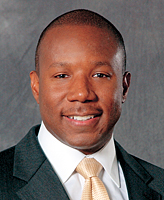
Stacking the deck against racism
Assistant Professor Robert Livingston offers a psychological explanation for impartiality
By Viviana Bompadre and Brad Wible
| |
 |
| |
Professor Robert W. Livingston
Photo © Evanston Photographic Studios |
| |
|
| |
| Adapted from KELLOGG INSIGHT articles based on the research of Kellogg professors. For the full text of these and other INSIGHT articles, please visit the KELLOGG INSIGHT Web site. |
|
| |
|
Many people don't consider themselves racially biased. The last presidential election would seem to prove that point, as Barack Obama won support that spanned racial boundaries unlike ever before.
But research from Kellogg Assistant Professor of Management and Organizations Robert W. Livingston and Brian Drwecki of the University of Wisconsin suggests that subconscious prejudices persist.
The reason, suggests Livingston, is that people are susceptible to affective conditioning, the psychological process by which we subconsciously associate emotions with things around us. He concludes that people who are more prone to associating things with negative emotions are also more prone to developing racial bias.
Livingston speculates that factors such as early childhood socialization may play a significant role. "If you live in an environment with lots of threat, you will be more prone to negativity because it is going to be more beneficial for you for survival purposes," he said. "If you are raised in a warmer, nurturing environment, because of the relative absence of threat, you might be more prone to focus on positivity."
The researchers studied more than 100 white undergraduate college students. Eighteen individuals were found to have extremely low or null levels of bias, based on how they consciously responded to comments such as, "It would not bother me if my new roommate was black,'' and how they played a simple game. Participants had to place words in one of two categories, either "white-unpleasant" or "black-pleasant." Categories were also switched to "white-pleasant" and "black-unpleasant." Subconscious bias was reflected by how fast stereotypically black or white names (for example, Jamel or Josh) and pleasant or unpleasant words (for example, peace or pain) were placed in the correct category.
To measure susceptibility to affective conditioning, participants were asked to look at several abstract Chinese symbols, presented one at a time on a screen. Each symbol was immediately followed by a pleasant or unsettling image. After seeing all the symbol-image pairs, participants were asked how fond they were of each symbol.
Participants also watched a conversation between white and black men, after which they had to remember which statement was made by which man. People who subconsciously categorize according to race were less likely to cross the racial boundary when making a mistake and assigning a statement to the wrong man (for example, to think that a white man said what was actually said by a black man).
Compared to the ordinary participants, the non-biased participants were less prone to let negative emotions influence their fondness for symbols, and were more prone to be influenced by positive emotions. Racial bias was also predicted by the tendency to categorize people by color, as reflected by the "which man said what" test. The two processes — categorization and affective conditioning — are different, but can overlap.
"There are certain people who are more likely to attach positive and negative affects to things in the world, and there are certain people who like to categorize individuals by race," explained Livingston. "If you put these two together, people who tend to categorize first notice that somebody is from a different race, and because of their differential conditioning they are more likely to attach negative aspects to that category."
The way to reverse these mechanisms, Livingston added, is through reconditioning. Friendships with other races and repetitive exposure to racial diversity can counteract the negativity through positive conditioning. |



